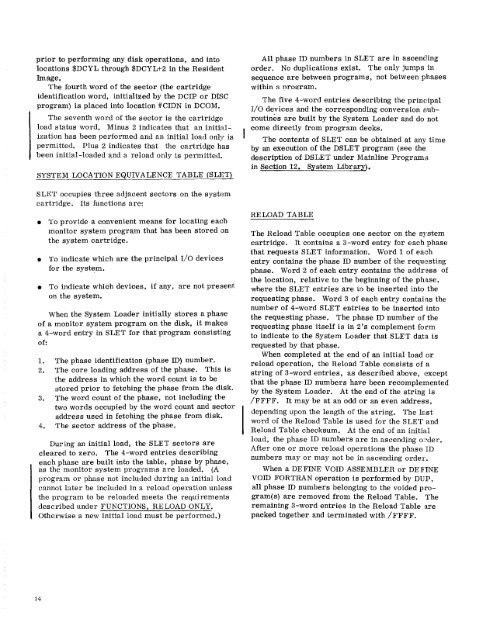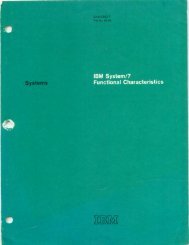Program Logic Manual - All about the IBM 1130 Computing System
Program Logic Manual - All about the IBM 1130 Computing System
Program Logic Manual - All about the IBM 1130 Computing System
You also want an ePaper? Increase the reach of your titles
YUMPU automatically turns print PDFs into web optimized ePapers that Google loves.
prior to performing any disk operations, and intolocations $DCYL through $DCYL+2 in <strong>the</strong> ResidentImage.The fourth word of <strong>the</strong> sector (<strong>the</strong> cartridgeidentification word, initialized by <strong>the</strong> DCIP or DISCprogram) is placed into location #CIDN in DCOM.The seventh word of <strong>the</strong> sector is <strong>the</strong> cartridgeload status word. Minus 2 indicates that an initializationhas been performed and an initial load only ispermitted. Plus 2 indicates that <strong>the</strong> cartridge hasbeen initial-loaded and a reload only is permitted.SYSTEM LOCATION EQUIVALENCE TABLE (SLET)SLET occupies three adjacent sectors on <strong>the</strong> systemcartridge. Its functions are:• To provide a convenient means for locating eachmonitor system program that has been stored on<strong>the</strong> system cartridge.• To indicate which are <strong>the</strong> principal I/0 devicesfor <strong>the</strong> system.• To indicate which devices, if any, are not presenton <strong>the</strong> system.When <strong>the</strong> <strong>System</strong> Loader initially stores a phaseof a monitor system program on <strong>the</strong> disk, it makesa 4-word entry in SLET for that program consistingof:1. The phase identification (phase ID) number.2. The core loading address of <strong>the</strong> phase. This is<strong>the</strong> address in which <strong>the</strong> word count is to bestored prior to fetching <strong>the</strong> phase from <strong>the</strong> disk.3. The word count of <strong>the</strong> phase, not including <strong>the</strong>two words occupied by <strong>the</strong> word count and sectoraddress used in fetching <strong>the</strong> phase from disk.4. The sector address of <strong>the</strong> phase.During an initial load, <strong>the</strong> SLET sectors arecleared to zero. The 4-word entries describingeach phase are built into <strong>the</strong> table, phase by phase,as <strong>the</strong> monitor system programs are loaded. (Aprogram or phase not included during an initial loadcannot later be included in a reload operation unless<strong>the</strong> program to be reloaded meets <strong>the</strong> requirementsdescribed under FUNCTIONS, RELOAD ONLY.O<strong>the</strong>rwise a new initial load must be performed.)<strong>All</strong> phase ID numbers in SLET are in ascendingorder. No duplications exist. The only jumps insequence are between programs, not between phaseswithin a nroaram.The five 4-word entries describing <strong>the</strong> principalI/O devices and <strong>the</strong> corresponding conversion subroutinesare built by <strong>the</strong> <strong>System</strong> Loader and do notcome directly from program decks.The contents of SLET can be obtained at any timeby an execution of <strong>the</strong> DSLET program (see <strong>the</strong>description of DSLET under Mainline <strong>Program</strong>sin Section 12. <strong>System</strong> Library).RELOAD TABLEThe Reload Table occupies one sector on <strong>the</strong> systemcartridge. It contains a 3-word entry for each phasethat requests SLET information. Word 1 of eachentry contains <strong>the</strong> phase ID number of <strong>the</strong> requestingphase. Word 2 of each entry contains <strong>the</strong> address of<strong>the</strong> location, relative to <strong>the</strong> beginning of <strong>the</strong> phase,where <strong>the</strong> SLET entries are to be inserted into <strong>the</strong>requesting phase. Word 3 of each entry contains <strong>the</strong>number of 4-word SLET entries to be inserted into<strong>the</strong> requesting phase. The phase ID number of <strong>the</strong>requesting phase itself is in 2's complement formto indicate to <strong>the</strong> <strong>System</strong> Loader that SLET data isrequested by that phase.When completed at <strong>the</strong> end of an initial load orreload operation, <strong>the</strong> Reload Table consists of astring of 3-word entries, as described above, exceptthat <strong>the</strong> phase ID numbers have been recomplementedby <strong>the</strong> <strong>System</strong> Loader. At <strong>the</strong> end of <strong>the</strong> string is/FFFF. It may be at an odd or an even address,depending upon <strong>the</strong> length of <strong>the</strong> string. The lestword of <strong>the</strong> Reload Table is used for <strong>the</strong> SLET andReload Table checksum. At <strong>the</strong> end of an initialload, <strong>the</strong> phase ID numbers are in ascending order.After one or more reload operations <strong>the</strong> phase IDnumbers may or may not be in ascending order.When a DEFINE VOID ASSEMBLER or DEFINEVOID FORTRAN operation is performed by DUP,all phase ID numbers belonging to <strong>the</strong> voided program(s)are removed from <strong>the</strong> Reload Table. Theremaining 3-word entries in <strong>the</strong> Reload Table arepacked toge<strong>the</strong>r and terminated with /FFFF.14
















